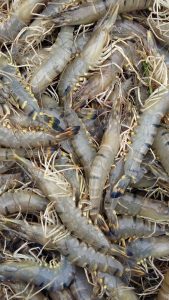 Experts at a consultation have emphasised on branding Bangladesh’s black tiger shrimp (BTS) or Penaeus monodon globally to boost export earnings from the sector that has remained stunted for more than a decade. They also suggested bringing massive infrastructural development in shrimp-growing regions with necessary investment to get desired output and exports from the newly-adopted vannamei species.
Experts at a consultation have emphasised on branding Bangladesh’s black tiger shrimp (BTS) or Penaeus monodon globally to boost export earnings from the sector that has remained stunted for more than a decade. They also suggested bringing massive infrastructural development in shrimp-growing regions with necessary investment to get desired output and exports from the newly-adopted vannamei species.
These observations were made at the last day of the CGIAR Expert Consultation Workshop styled ‘Rethinking Food Markets and Value Chains for Inclusion and Sustainability,’ which was held on January 22, reported by the Financial Express. CGIAR is a global research partnership that works for a food-secure future, dedicated to transforming food, land, and water systems amid the climate crisis.
Enthusiasm about shrimp production and exports has gradually been fading away from thissector since fiscal year 2013-14. According to the Export Promotion Bureau (EPB), shrimp export reached its peak at USD550 million in FY14 and started falling since then.
Meanwhile, the CGIAR did a scoping study to document the issues facing the sector, including interviews with 25 multi-stakeholder experts, following the workshop. Although vannamei approvals and trials are ongoing, the study revealed, initial enthusiasm and optimism around its export prospects are somewhat tempered. Most stakeholders believe Bangladesh’s best opportunities remain in bagda or BTS with a focus on international market development and global branding. Experts also pointed to a growing domestic market for shrimp and freshwater prawn.
The International Food Policy Research Institute, WorldFish, the Alliance of Bioversity International and the International Center for Tropical Agriculture jointly organised the event, styled “Rethinking Food Markets and Value Chains for Inclusion and Sustainability”. The study noted that despite some improvements in yields and the adoption of modern technical practices, including farm and feed management, significant structural problems continue to plague the industry, reports the Daily Star. There was a consensus that shrimp, unlike other species, needs technical knowledge to produce.
In the absence of such knowledge, shrimp farming becomes a high-risk venture for small farmers, said Mohammad Mahfujul Haque, a professor of aquaculture at Bangladesh Agricultural University in Mymensingh.
Specific pathogen-free post larvae
There is also an associated challenge of ensuring that farmed shrimp is free from disease. Bangladesh now has at least three hatcheries that produce specific pathogen-free post-larvae, which reduces these risks. However, the present extensive shrimp farming systems limit the ability of farmers to maintain biosecurity. Recent data suggests that most ponds that grow shrimp in fact also grow substantial quantities of fish. In 2010-11, of the total output from “shrimp farmsâ€, as much as 47% were fish; by 2020-21, the share of fish had grown to 53%. While such farms limit the scope of specializing and cultivating shrimp intensively, this strategy protects the farmers from the high risks associated with shrimp farming (dhakatribune.com)
Professor Mohammad Mahfuzul Haque of aquaculture department said a third-party branding of tiger shrimp is needed to boost export globally. Experts said that there may also be opportunities to target niche markets for shrimp based on sustainable production practices.
Haque said, “BTS is a unique species of Bangladesh and we need certification for our safe products from globally recognised certification agencies, and organisations. To get that certification, we need to adopt good aquaculture practices, we have to use specific pathogen-free (SPF) broodstock and should bring some infrastructural changes too,†added Haque.
The government has recently endorsed vannamei production. “Apart from BTS, we will also try vannamei. But we need specific market research, the global trend, massive infrastructural development and investments for vannamei,” said Haque.
Monoj Kumar Mistri, deputy project director of Sustainable Shrimp Farming project run by fisheries department, said that 7,500 farmers under 300 clusters have been using post larvae from SPF broodstocks under his project. He said production has increased to 1,500kg/ha from 500kg earlier.
Mistri said three hatcheries now supply 700-million post-larvae (PL) while the demand is 10-billion PL. Many companies will be transformed into SPF hatcheries soon then production would surpass 5.0-billion PL. Meanwhile, Prof Haque cited that the lack of local shrimp feed companies is a great problem for the sector. The country is fully dependent on imported shrimp feed.
There is also a need for a holistic policy for shrimp and a dedicated agency committed to developing the industry, he added. Different stakeholders think the policies supporting the industry are more exporter-centric, but it is time to build a farmer-focused policy that enables them to overcome the many constraints they face.
The sector ensures the livelihood of more than 800,000 farmers, who collectively farm shrimp on 2.63 lakh (263,000) hectares of land in coastal areas of the country’s southwest region, according to the Department of Fisheries (Source: The Daily Star).




